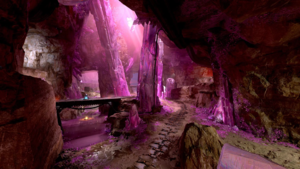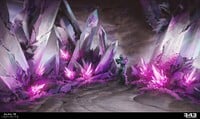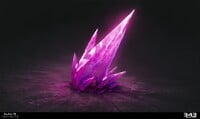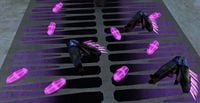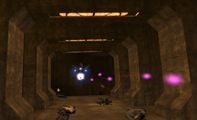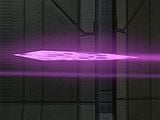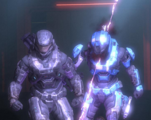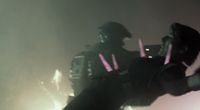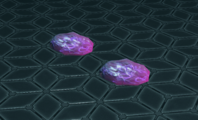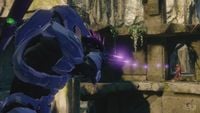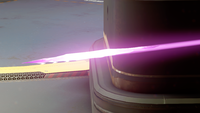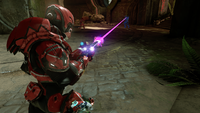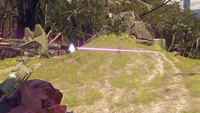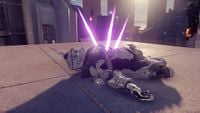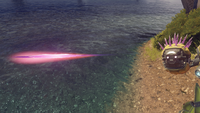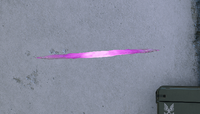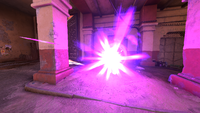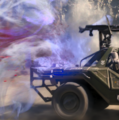Kemuksuru
From Halopedia, the Halo wiki
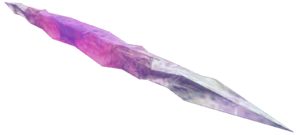
Kemuksuru,[1] colloquially known as Subanese crystal or Blamite, is a crystalline, high-explosive material used in various needle-based weaponry, including in the ammunition of Gadulo-pattern needle rifles, Type-33 Needlers, Type-56D needlers, Posu'gelka-pattern needlers, and needle cannons.[2] The crystals are mined from veins found throughout the interior of Suban, one of Sanghelios' two natural satellites.[3][4]
Overview[edit]
Characteristics[edit]
Kemuksuru is one of the few unique ammunition types in Covenant arsenal. When used as ammunition, kemuksuru is capable of two types of damage to a target; penetration, damage caused by the needles impacting flesh and entering it; and the usually-resulting supercombine, the combined explosion of multiple needles wedged in the body. A crystalline projectile can cause fatal damage to its victim—a single shard can cause internal bleeding or strike a vital organ, with untreated wounds resulting in death. The resulting detonation of the shard upon penetration also spreads micro-shrapnel throughout the victim. Depending on the impact area and angle, several crystalline shards can cause amputation of limbs, and impacts to the chest are in most cases fatal; the supercombine properties can easily crack ribs, damage the lungs or heart, and cause severe flesh damage that can be very difficult and often impossible to repair. If enough rounds impact and detonate simultaneously, the unfortunate target can quite literally be blown apart.
While used in both needle rifles and Needlers, the kemuksuru needles behave differently in these weapons when fired. Needles fired from a Needler appear to have some sort of "identify-friend/foe" function, as they will home in on hostile targets, but not allies of the wielder. Needles fired from a needle rifle lack this function, behaving more like traditional projectiles, but are much faster and require fewer embedded rounds to cause a lethal supercombine. The energy cutlass, a melee weapon used predominantly by Kig-Yar, uses a kemuksuru shard as the blade. When thrust into a soft target, the blade will explode violently similar to a Needler shard.[5] The Lance of Suban, a variant of Type-1 energy sword, is infused with kemuksuru, giving the blade the same bright pink color commonly associated with the crystal. These energy swords are only wielded by Sangheili native to Suban.[6]
History[edit]
Pre-Covenant and Covenant use[edit]
Kemuksuru was used by the Sangheili in their early weapon designs, prior to the establishment of the Covenant in 852 BCE. Suban is the only known location of kemuksuru veins, and some believed that the moon is the only world where the crystals exist. Although the crystals had been studied and documented for thousands of years by the Covenant, the properties of kemuksuru remain perplexing to all. However, it is believed that the San'Shyuum may have covertly created highly specialized publications on kemuksuru and its properties, but any such documents would have likely been destroyed alongside High Charity and its vast records complexes in 2552.[4] Due to the vast size of the Covenant Empire, hundreds of carefully curated storage facilities were employed across dozens of systems to serve as local waystations for Covenant fleets seeking to restock their stores, kemuksuru being among the stocks of these facilities. Following the Human-Covenant War, these facilities were often raided by numerous factions and kemuksuru became a relatively attainable material. Subanese miners, while primarily serving the Swords of Sanghelios, have also supplied other factions and species—willing to pay the gekz—with kemuksuru regardless of affiliation.[7]
Post-war advancements[edit]
With the Covenant's demise, Sangheili artisan-armorers garnered renewed interests in discovering the properties of kemuksuru. Many pre-Covenant design patterns incorporating kemuksuru have been uncovered to assist in the research. Human scientists had also began to express interest in the crystals, especially in regards to exploiting the energy-storage properties of kemuksuru.[4] United Nations Space Command and Sangheili researchers have since collaborated in an attempt to discover the properties and functions of kemuksuru in Kolaar Manufactorum on Sanghelios. However, the results yielded from the research was listed as inaccessible by the Office of Naval Intelligence.[8] AMG Transport Dynamics Motorsport Manager Erik Burch proposed the creation of an M12 Warthog variant which would have made use of a pair of experimental kemuksuru afterburners, but the project was canceled by AMG's Special Projects Director Tyse Jenkins as he found Bursch's idea too outlandish.[9]
The Blood of Suban variant of the Mosa-pattern carbine fires carefully carved Subanese crystal shards capable of penetrating armor and sympathetically detonating in lethal 'supercombine' explosions.[10] The Sword Warthog features an M343A2 chaingun that fires kemuksuru and is one of several innovations stemming from cooperation between the UNSC and the Swords of Sanghelios.[11] Unggoy Pnap-pattern Goblins are armed with a double-barreled heavy needle cannon capable of dealing significant damage to vehicles and fire a barrage of blamite that can target up to eight different hostiles.[12] In the post-war era, Covenant remnants and the Banished commonly employ Blamex; an explosive substance derived from the Subanese crystal.[13]
Trivia[edit]
- The name "blamite" originates from Bungie's method of censoring swearing on their forums, which replaces objectionable words with -blam!-.[14]
- Killing 10 enemies in either Firefight or campaign with a supercombine explosion without dying in Halo: Reach unlocks the achievement, A Spoonful of Blamite.[15]
Gallery[edit]

|
Browse more images in this article's gallery page. |
Concept art[edit]
Halo Wars 2: Awakening the Nightmare concept art for a kemuksuru variant of the Floor Blades fortification (left). This variant was cut from the final release.
Screenshots[edit]
Blamite encased in a T-33 Needler ammunition casing in Halo: Combat Evolved.
T-33 Needlers and their kemuksuru ammuniton cases in a Flood containment facility.
An Aggressor Sentinel firing kemuksuru during the Battle of Installation 05 in Halo 2.
A blamite shard in Halo 3.
A blamite shard in flight in Halo 3.
Catherine-B320 is killed by a T-31 needle rifle's kemuksuru during the Siege of New Alexandria in Halo: Reach.
Kennedy Mehaffey is killed by kemuksuru during the Battle of Circinius IV in Halo 4: Forward Unto Dawn.
A kemuksuru shard in flight in Halo 4.
Cut kemuksuru encased in T-33 Needler ammunition casings in Halo 2: Anniversary.
A Mark VI-clad Spartan firing kemuksuru from a T-33 Needler on Shrine in Halo 2: Anniversary.
A NOBLE-clad Spartan-IV firing kemuksuru from a Talon of the Lost on March on Stormbreak.
A Cinder-clad Spartan-IV firing kemuksuru from a Blood of Suban on Attack on Sanctum.
A Sword Needle Warthog's M343A2 chaingun fires kemuksuru on Raid on Apex 7.
A supercombine explosion from a Posu'gelka-pattern needler on Bazaar.
A UNSC Marine is supercombined by a needler in Halo: The Television Series.
List of appearances[edit]
Sources[edit]
- ^ Halo: Battle for the Blood-Moon
- ^ Bungie.net: The Bungie Podcast: 1/27/2010 (Sage Merrill at 36:40: "It is the equivalent on the Covenant side of the DMR. It is their sort of medium-range, repression rifle. As with all the blamite weapons, it does supercombine.") (audio podcast)
- ^ Halo: The Essential Visual Guide, page 128
- ^ a b c Halo Waypoint, Universe - Weapons - Needler (Retrieved on Apr 21, 2021) [local archive] [external archive]
- ^ Halo: Contact Harvest, page 130
- ^ Halo Waypoint, Canon Fodder - Art of Wort (Retrieved on Jun 23, 2021) [archive]
- ^ Halo Waypoint, Canon Fodder - Crown Jul (Retrieved on Mar 28, 2017) [archive]
- ^ Halo Waypoint, Forums - Catalog Interaction (post 2969311) (Retrieved on Oct 14, 2014) [local archive] [external archive]
- ^ Halo Waypoint, Canon Fodder - Needle Me This (Retrieved on Jul 16, 2019) [archive]
- ^ Halo Waypoint, Canon Fodder - Armory Armore (Retrieved on Oct 24, 2016) [archive]
- ^ Halo Waypoint, Canon Fodder - Tales & Stingers (Retrieved on Jun 7, 2016) [archive]
- ^ Halo Waypoint, Canon Fodder - Buzz Generating (Retrieved on Sep 14, 2016) [archive]
- ^ Halo: Shadows of Reach, chapter 18
- ^ Bungie.net, Legendary Map: Avalanche
- ^ Bungie.net: Bungie Weekly Update 07.30.10
